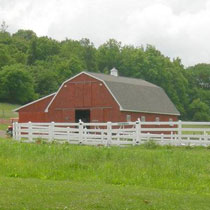Barns are interesting structures and Connecticut has lots of them tucked away across the state. When we think of barns, most of us envision a big red building with white trim that we imagine has, what: Cows? Horses? The occasional cat or dog? That’s true, many barns do look like that and do, indeed, house a few domestic animals. But barns are bigger than that, so to speak. There are varieties of barns or outbuildings that support agricultural businesses serving all kinds of specific purposes here in Connecticut. To name a few, there are:
- Tobacco Barns
- Horse Barns
- Dairy Barns
- Poultry Barns
Probably loads more fit the category of holding livestock (llama barns?), but if we stretch the imagination a little, the notion can be extended out to include:
- Wineries
- Lobster pounds (well, you have to wrangle those lobsters somewhere!)
- Trout hatcheries
- Oyster beds (you can hardly put hatcheries and oyster beds in a barn, but they are farmed)
Then there are the miscellaneous structures that we often classify as “barns,” or outbuildings at least. If you live in a suburban home that’s more than about 75 years old and have a bit of land attached to the property, there was probably a carriage house at some point in time, if it isn’t still there. Carriage houses are a thing of the past, but they used to contain the household’s means of transport: the horse and buggy. Now we just call it a garage. Greenhouses (those wonderful structures that help start seedlings for early spring planting and overwinter plants that are less hardy in our climate) were a fairly big industry in the 1920s and still do a thriving business today.
Even the University of Connecticut started its life as an agriculture school back in 1881. The following is from the UCONN website:
Connecticut Gov. Hobart Bigelow signs legislation accepting Charles and Augustus Storrs’ gift of a former orphanage, 170 acres of farmland, $6,000, and a few barns, and establishing Storrs Agricultural School. Classes begin on Sept. 28 with three faculty members and 13 males enrolled.
Barns, farming and the land are a significant part of our history.
So remember, when you’re wandering around the Connecticut countryside or casting your eye out across a field and spy a picturesque broken-down barn, think about Connecticut’s deep agricultural roots and how its little farms are making a big comeback.
Other resources:
ConnecticutBarns.org – A product of The Connecticut Trust for Historic Preservation, this site is a great resource for identifying all kinds of barns and identifies where they are in the state. They have a mobile app, too!
WorkingtheLand.com – A documentary covering Connecticut’s agricultural tradition.









